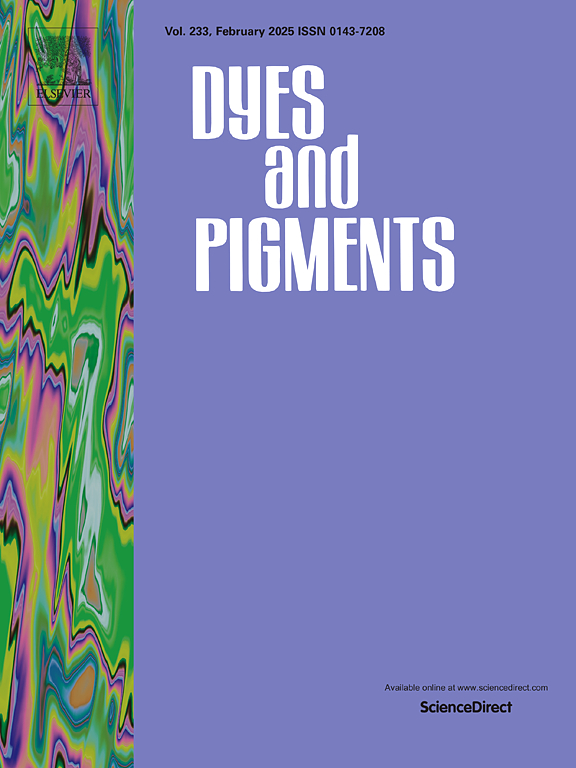A dual-responsive fluorescent probe based on Zn(II)-MOF and its mixed-matrix membranes for efficient detection of 3-nitrotyrosine biomarker and dimetridazole in actual samples
IF 4.1
3区 工程技术
Q2 CHEMISTRY, APPLIED
引用次数: 0
Abstract
With ever-increasing concern about human health, the detection of biomarkers and food security have become a crucial issue in recent years. In this work, we prepared a water-stable and thermal stable Zn(II) metal-organic framework {[Zn(BBIP)(H4BDPT)1/2]·DMF}n (BDPT-Zn2) by the amide-modified flexible-aromatic linker bis(3,5-dicarboxyphenyl)terephthalamide (H4BDPT) and the N-containing ligand 3,5-bis(1H-benzo[d]imidazole-1-yl)pyridine (BBIP). Structure analysis revealed that BDPT-Zn2 exhibited a two-dimensional (2D) network structure and crystallized in the triclinic system with space group P—1. BDPT-Zn2 demonstrated dual-responsive sensing capability toward 3-nitrotyrosine (3-NT) biomarker and dimetridazole (DTZ) through fluorescence quenching, with low detection limits of 0.0246 μM and 0.00257 μM, respectively. Then, the sensor had potential practical application in real samples, with good recovery ranging from 96.10 % to 105.35 %. Furthermore, the fluorescent mixed matrix membranes (BDPT-Zn2@MMMs) were prepared by dispersing the particles of BDPT-Zn2 within the matrix of polymethyl methacrylate, and showed a promising fluorescent probe for visual, real-time and recyclable detection of 3-NT and DTZ in real samples.

基于Zn(II)-MOF及其混合基质膜的双响应荧光探针用于实际样品中3-硝基酪氨酸生物标志物和二甲硝唑的高效检测
近年来,随着人们对人类健康的日益关注,生物标志物的检测和食品安全已成为一个至关重要的问题。本文采用酰胺修饰的柔性芳香连接剂双(3,5-二羧基苯基)对苯二胺(H4BDPT)和含n配体3,5-双(1h -苯并[d]咪唑-1-基)吡啶(BBIP)制备了水稳定和热稳定的Zn(II)金属-有机骨架{[Zn(BBIP)(H4BDPT)1/2]·DMF}n (BDPT-Zn2)。结构分析表明,BDPT-Zn2呈二维(2D)网状结构,在空间群P-1的三斜体系中结晶。BDPT-Zn2通过荧光猝灭对3-硝基酪氨酸(3-NT)和二甲硝唑(DTZ)具有双响应传感能力,检测限分别为0.0246 μM和0.00257 μM。因此,该传感器在实际样品中具有潜在的实际应用价值,回收率在96.10% ~ 105.35%之间。此外,将BDPT-Zn2颗粒分散在聚甲基丙烯酸甲酯基质中制备了荧光混合基质膜(BDPT-Zn2@MMMs),显示出一种具有视觉、实时和可回收性的荧光探针,可用于实际样品中3-NT和DTZ的检测。
本文章由计算机程序翻译,如有差异,请以英文原文为准。
求助全文
约1分钟内获得全文
求助全文
来源期刊

Dyes and Pigments
工程技术-材料科学:纺织
CiteScore
8.20
自引率
13.30%
发文量
933
审稿时长
33 days
期刊介绍:
Dyes and Pigments covers the scientific and technical aspects of the chemistry and physics of dyes, pigments and their intermediates. Emphasis is placed on the properties of the colouring matters themselves rather than on their applications or the system in which they may be applied.
Thus the journal accepts research and review papers on the synthesis of dyes, pigments and intermediates, their physical or chemical properties, e.g. spectroscopic, surface, solution or solid state characteristics, the physical aspects of their preparation, e.g. precipitation, nucleation and growth, crystal formation, liquid crystalline characteristics, their photochemical, ecological or biological properties and the relationship between colour and chemical constitution. However, papers are considered which deal with the more fundamental aspects of colourant application and of the interactions of colourants with substrates or media.
The journal will interest a wide variety of workers in a range of disciplines whose work involves dyes, pigments and their intermediates, and provides a platform for investigators with common interests but diverse fields of activity such as cosmetics, reprographics, dye and pigment synthesis, medical research, polymers, etc.
 求助内容:
求助内容: 应助结果提醒方式:
应助结果提醒方式:


